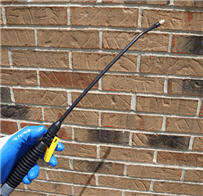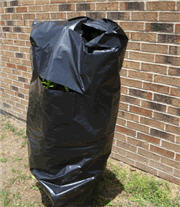Notes on Sealing Brick

By doing yourself, you can save on sealing your own exterior brick, considering that many outfits charge $2 per foot and more.
There are several points of focus that can help maximize your results and avoid pitfalls during the process.
Apply A Quality Sealer - The sealer should be applied out of
direct sunlight, and do not apply during very hot days. If there is any efflorescence
or staining this must be removed and any pointing should be complete with adequate
wait time. For the sealer itself, consider a commercial grade, those liquids that are
siloxane-based even though they come at a per-gallon premium.
Important: verify with the manufacturer that the dried application will result in a 'dried look' and
not a 'wet one' if this is what you want.
Also that it is compatible with your type of brick unit.
Be aware that some of the cheaper, big name all-purpose sealers suprisingly begin to break down and degrade even within
months of being applied, or they discolor.
A few qualities to look for in a sealer, based on your application are:
UV stability over time
Performance over a vast temperature range, taking your particular climate into consideration
Above or below ground formulations - is this for vertical/walls or horizontal/walking surfaces
Protection against staining and mildew
If you are uncertain what type of sealer was applied previously, if any, then wait a sufficient
amount of time before sealing again for compatibility.
Ordering Sealer - Soft brick and old mortar absorbs considerably. There should be quantities to complete the
project and doing it wall by wall. The single gallons are usually returnable so it can be wise to order more than needed.
Caveat: some commercial sealers must be custom-ordered in minimum amounts.
 Protecting Surrounding Areas
Protecting Surrounding Areas - The seal mist coming off the sprayer is thin. This
has a tendency to travel deceptively, up to thirty feet and more. Some penetrating sealers are difficult
to remove off many surfaces. Take all best efforts to prevent this; cover with plastic, move cars and anything nearby, and
spray when there is no air movement.
Completed Consistency/Mortar Additives - only after the mortar is cured should the sealer be put on. If any modifier
has been combined with the mortar, such as acro-60 while repointing there can be a darker variation in the dry sealer. And this is
where the sealer was not allowed to penetrate as elsewhere.
For minor cracks that are silicone-caulked beforehand, these areas when wiped leave a residue that will repel the sealer.
To apply the silicone cleanly, cut the tip no wider than the narrowest void on a hand tube.
Some masons claim that masking on
either side of the crack can help, but the line must be straight enough and the tape must stick.
If there exists any mortar residue like from tuckpointing, this must first be cleaned or it will remain.
Painting Brick - Applying coatings other than sealer can curtail the brick lifespan.
They might even cause spalling, where the faces of the brick pop off in spots due to the trapped moisture.

 By doing yourself, you can save on sealing your own exterior brick, considering that many outfits charge $2 per foot and more.
There are several points of focus that can help maximize your results and avoid pitfalls during the process.
By doing yourself, you can save on sealing your own exterior brick, considering that many outfits charge $2 per foot and more.
There are several points of focus that can help maximize your results and avoid pitfalls during the process.
 Protecting Surrounding Areas - The seal mist coming off the sprayer is thin. This
has a tendency to travel deceptively, up to thirty feet and more. Some penetrating sealers are difficult
to remove off many surfaces. Take all best efforts to prevent this; cover with plastic, move cars and anything nearby, and
spray when there is no air movement.
Protecting Surrounding Areas - The seal mist coming off the sprayer is thin. This
has a tendency to travel deceptively, up to thirty feet and more. Some penetrating sealers are difficult
to remove off many surfaces. Take all best efforts to prevent this; cover with plastic, move cars and anything nearby, and
spray when there is no air movement.